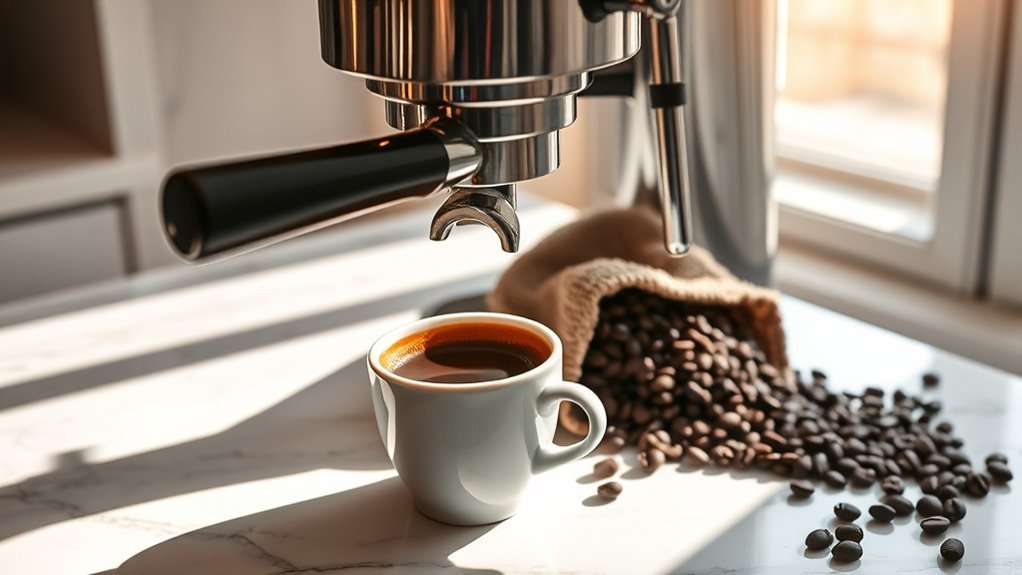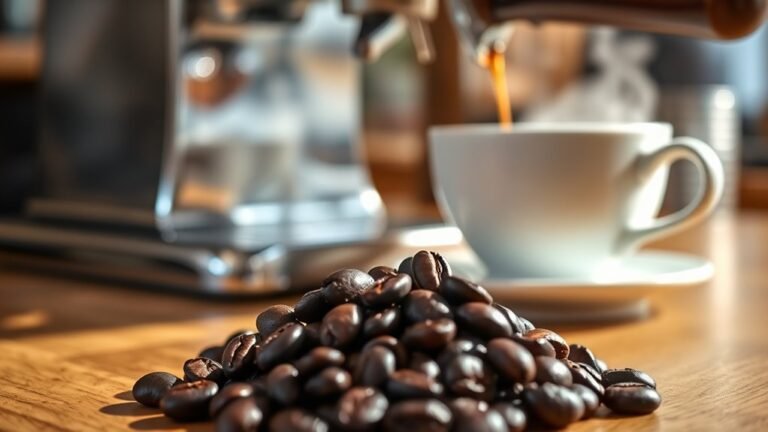Can You Put Regular Coffee in an Espresso Machine
Yes, you can use regular coffee in an espresso machine, but expect variable results due to differences in grind size, extraction methods, and flavor profiles. Regular coffee typically requires adjustments to achieve a proper extraction, as its characteristics differ markedly from espresso beans. Grind size plays a vital role, and experimenting with various beans and brewing times can lead to enjoyable surprises. If you’re curious about maximizing your results, there’s more to discover on this topic.
Understanding the Difference Between Regular Coffee and Espresso
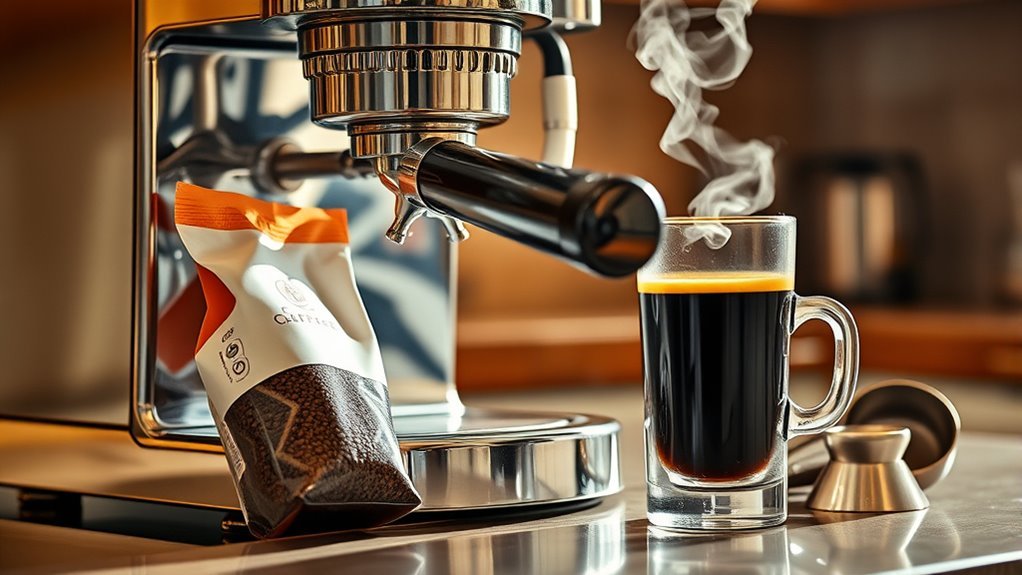
While both regular coffee and espresso originate from the same coffee beans, their preparation methods and resulting flavor profiles set them apart. Regular coffee typically employs a drip or pour-over brewing method, allowing water to flow slowly through coffee grounds. This results in a milder flavor and a larger volume of coffee. In contrast, espresso uses a pressurized brewing method that forces hot water through finely-ground coffee, resulting in a concentrated shot with a rich, bold taste. The key difference lies in the grind size, brewing time, and water temperature, which directly affect the extraction process. Understanding these distinctions between brewing methods and coffee types can empower you to choose the right beverage for your preferences and coffee experiences.
The Espresso Brewing Process Explained
To fully appreciate the richness of espresso, it’s important to understand its unique brewing process. This process involves high pressure and precise temperature to extract flavors rapidly, distinguishing it from other brewing techniques. Many espresso myths suggest that any coffee can be used, but the grind size, coffee type, and brewing time are essential for achieving that signature crema and bold taste.
| Step | Description | Key Considerations |
|---|---|---|
| Grinding | Fine grind is critical | Consistency is key |
| Tamping | Compact the grounds evenly | Pressure matters |
| Brewing | Apply 9 bars of pressure | Timing affects flavor |
| Extraction | Aim for 25-30 seconds | Monitor for balance |
| Serving | Enjoy immediately | Freshness is crucial |
Understanding these elements enhances your espresso experience.
Can Regular Coffee Beans Work in an Espresso Machine?
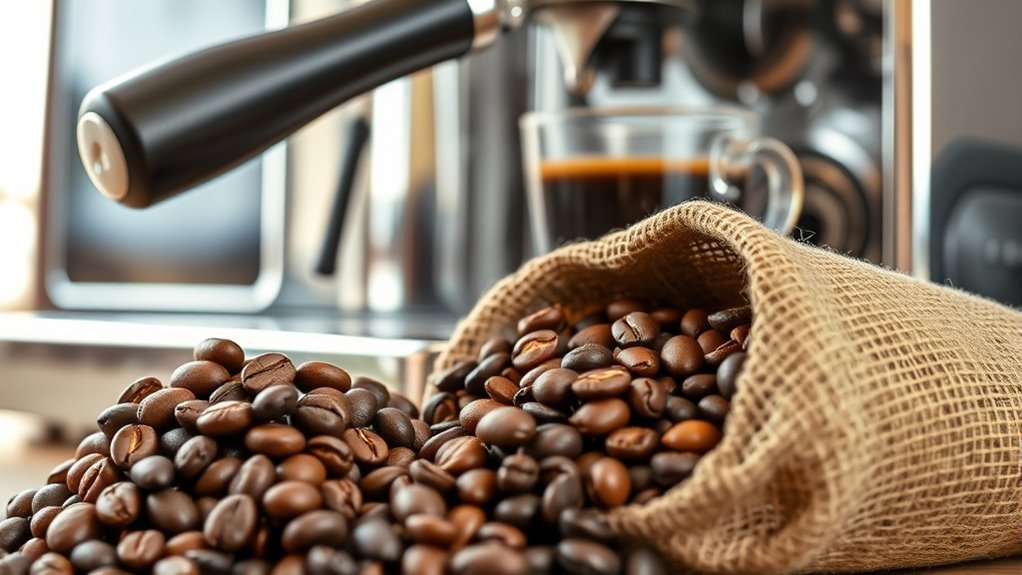
Using regular coffee beans in an espresso machine raises important considerations about bean type, grind size, and the brewing process itself. While you might think any coffee can work, the specific characteristics of espresso brewing demand a finer grind and a robust flavor profile typical of espresso beans. Understanding these differences will help you achieve the best results when experimenting with regular coffee in your espresso machine.
Bean Type Importance
Although many espresso enthusiasts swear by specialty beans, regular coffee beans can also be used in an espresso machine, provided you understand their limitations. The choice of bean varieties plays a significant role in your espresso’s flavor profile. Regular coffee beans, typically found in grocery stores, often feature a wider range of roast levels, from light to dark. However, these beans might lack the complexity and unique notes that specialty beans offer. Darker roasts may produce a bold taste but can also lead to bitterness. On the other hand, lighter roasts may not extract well under high pressure. By selecting the right bean variety and roast level, you can achieve a satisfactory espresso experience using regular coffee beans.
Grind Size Considerations
When it comes to brewing espresso with regular coffee beans, the grind size is a critical factor that can make or break the extraction process. Ideally, you want a fine grind that promotes peak extraction, but using regular beans may complicate things. Grind uniformity is essential; uneven particles can lead to channeling and inconsistent flavors. You’ll need to experiment with grind adjustments to achieve the right consistency for your machine. If the grind is too coarse, you might end up with a weak shot, while an overly fine grind can result in bitterness and over-extraction. Fine-tuning these variables will empower you to harness the full potential of regular coffee beans in your espresso machine.
Brewing Process Differences
The grind size you’ve achieved plays a significant role in how regular coffee beans perform in an espresso machine, but the brewing process itself introduces additional complexities. Espresso relies on high pressure and quick extraction, which can be challenging when using regular coffee beans. If you haven’t adjusted your brewing methods, you might find that the coffee quality suffers. Regular beans typically don’t have the same oil content or flavor concentration as espresso beans, leading to a less intense shot. Furthermore, the extraction time for espresso is drastically shorter than for other brewing methods, potentially resulting in under-extraction. Ultimately, while you can use regular coffee beans, understanding these brewing process differences is essential for maximizing your coffee experience.
The Impact of Grind Size on Brewing

Grind size plays a vital role in how your coffee brews, affecting both extraction time and flavor profile. If the grind is too coarse, you might end up with under-extracted, sour notes, while a fine grind could lead to over-extraction and bitterness. Understanding these nuances can help you achieve a balanced and satisfying cup from your espresso machine.
Grind Size Importance
Although many factors influence the brewing process, grind size plays a significant role in determining the flavor and strength of your coffee. When you use regular coffee in an espresso machine, achieving the right grind consistency is essential. A finer grind typically extracts flavors more effectively, producing a richer espresso. However, if the grind is too fine, it can lead to over-extraction and bitterness. That’s where grind adjustments come in; making small tweaks can dramatically affect your brew. You’ll find that experimenting with grind size allows you to tailor your coffee experience. Ultimately, understanding the importance of grind size empowers you to explore new flavor profiles, granting you the freedom to create your perfect cup.
Extraction Time Differences
When brewing coffee, understanding extraction time is essential, especially when using regular coffee in an espresso machine. The grind size directly impacts brewing efficiency and extraction time. Finer grinds extract more quickly, which is vital for espresso, while coarser grinds take longer. If you use regular coffee, adjusting the grind size can help achieve better results. Here’s a comparison to illustrate the differences:
| Grind Size | Extraction Time (seconds) | Brewing Efficiency (%) |
|---|---|---|
| Coarse | 30-40 | 50 |
| Medium | 25-30 | 70 |
| Fine | 20-25 | 90 |
Flavor Profile Variations
The choice of grind size not only influences extraction time but also greatly affects the flavor profile of the brewed coffee. When you use a finer grind, you typically enhance flavor intensity, resulting in a richer, bolder cup. Conversely, a coarser grind can lead to a milder taste, often lacking the complexity that espresso aficionados seek. Additionally, aroma differences become more pronounced with the grind size; finer particles release volatile compounds more effectively, amplifying the overall sensory experience. If you want to explore the depths of flavor in your coffee, experimenting with grind size is essential. Ultimately, the grind determines not just taste, but your entire coffee journey—allowing you to embrace the freedom of customization.
Flavor Profiles: What to Expect When Using Regular Coffee
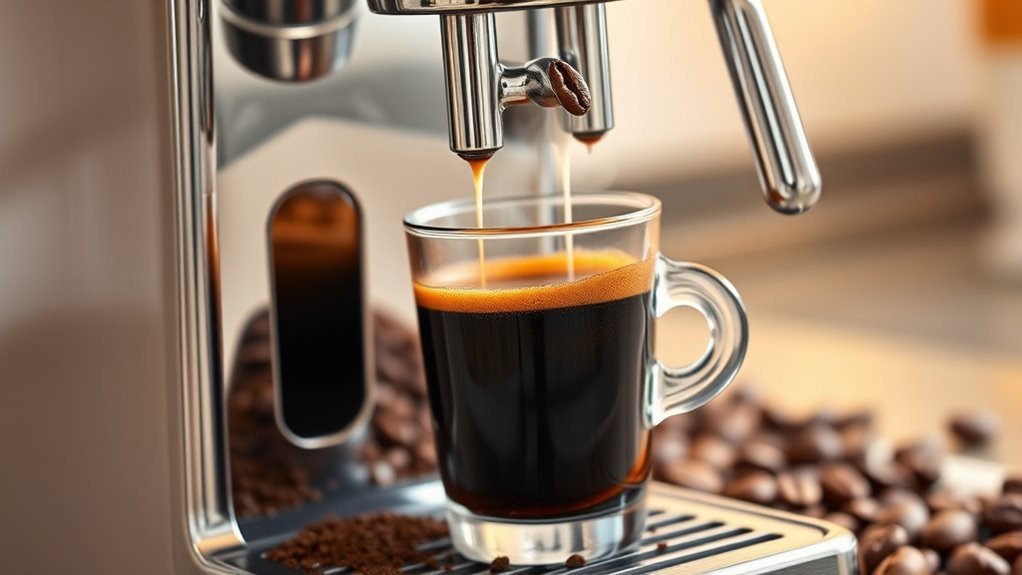
How does using regular coffee in an espresso machine impact the flavor profile of your brew? When you opt for regular coffee, you might notice a shift in the complexity of flavors compared to traditional espresso. Regular coffee typically has a milder profile, which can result in a less intense coffee tasting experience. The brewing techniques used in espresso machines—high pressure and short extraction times—can amplify certain notes, but with regular coffee, these may not fully develop. Instead, you might encounter a smoother, more subdued taste, often lacking the rich crema and robust body associated with espresso. This can lead to a unique but different drinking experience, making it essential to explore various regular coffee beans to find your preferred flavor.
Tips for Experimenting With Regular Coffee in Your Espresso Machine
While experimenting with regular coffee in your espresso machine can be rewarding, it requires careful attention to grind size, dose, and brewing time. Start by adjusting the grind size; a finer grind is essential for proper extraction, so consider using a burr grinder for consistency. Next, explore different coffee blends; some may yield better results than others. Use the right dose, typically around 18-20 grams for a double shot, and adjust according to taste. Experiment techniques like varying brewing times can also influence flavor—try 25-30 seconds for ideal extraction. Document your results, noting what works and what doesn’t, which will guide you in refining your process. Embrace the freedom to innovate, and enjoy the journey of discovery!
Final Thoughts on Using Regular Coffee for Espresso Shots
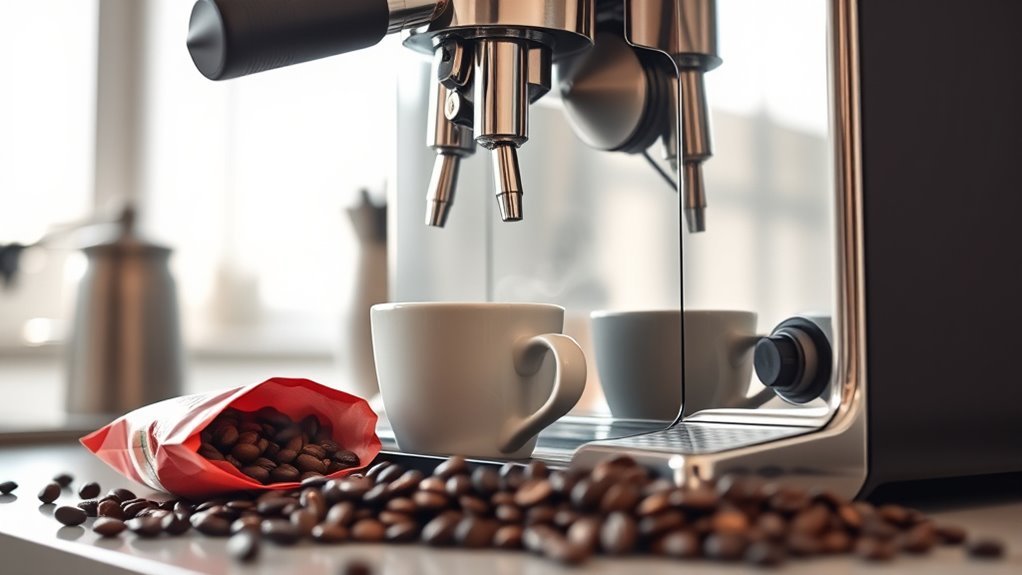
Although many purists might argue against using regular coffee in espresso machines, experimenting with this approach can yield surprising and enjoyable results. If you’re considering espresso alternatives, here are a few points to keep in mind:
Experimenting with regular coffee in espresso machines can lead to delightful discoveries and broaden your coffee horizons.
- Flavor Profile: Regular coffee can provide unique flavors, allowing you to explore your coffee preferences beyond traditional espresso.
- Brew Time: Adjusting grind size and brew time is essential for extracting the best flavors from regular coffee in an espresso machine.
- Creativity: Don’t hesitate to mix different coffee beans to create a personalized blend that suits your taste.
Ultimately, experimenting with regular coffee can expand your coffee experience, inviting you to discover new favorites while challenging conventional notions of espresso. Embrace the freedom to innovate!
Frequently Asked Questions
Can I Use Flavored Regular Coffee in an Espresso Machine?
Sure, you can use flavored regular coffee in an espresso machine, but it’s like dressing a fine wine in a clown suit. Flavored coffee types, like vanilla or hazelnut, might clash with the rich, bold espresso flavor profiles. You’ll get a unique brew, but don’t expect the complexities of a traditional espresso. If you’re seeking freedom in your coffee creations, experiment away, but be ready for some unexpected results.
Will Using Regular Coffee Damage My Espresso Machine?
Using regular coffee in your espresso machine won’t damage it, but you might face issues with espresso machine maintenance. Regular coffee typically has a coarser grind size than espresso, which can lead to uneven extraction and affect flavor. If you choose to use it, make sure you adjust the grind size for best results. Over time, improper grind sizes can lead to clogs, so keeping your machine clean is essential for maintaining its performance.
How Does Water Temperature Affect Regular Coffee in Espresso Machines?
Imagine hot water cascading over freshly ground coffee, releasing its rich aromas and flavors. The temperature of that water plays an essential role in water extraction and brewing efficiency. If it’s too low, you might end up with a weak, underwhelming brew. If it’s too high, bitterness can overpower the natural sweetness. Finding the sweet spot in water temperature guarantees you get a balanced cup, allowing you to enjoy every sip without compromise.
Can I Mix Regular Coffee With Espresso Shots?
You can definitely mix regular coffee with espresso shots, but it’s important to take into account the balance of flavors. An espresso blend is crafted for ideal coffee extraction, delivering rich and concentrated flavors. When you combine it with regular coffee, you might dilute the intensity, resulting in a unique but less robust beverage. Experimenting with ratios can help you find a blend that suits your taste while still allowing the espresso’s character to shine through.
What Is the Best Regular Coffee Brand for Espresso Machines?
When searching for the best regular coffee brand for espresso machines, you’ll want to take into account espresso compatibility. Look for brands that offer finely ground coffee specifically designed for espresso, as this guarantees optimal extraction. Some top contenders include Lavazza, Illy, and Peet’s Coffee. Each provides a unique flavor profile while assuring you get that rich crema you crave. Ultimately, trial and error can help you discover your ideal blend for an exceptional espresso experience.
